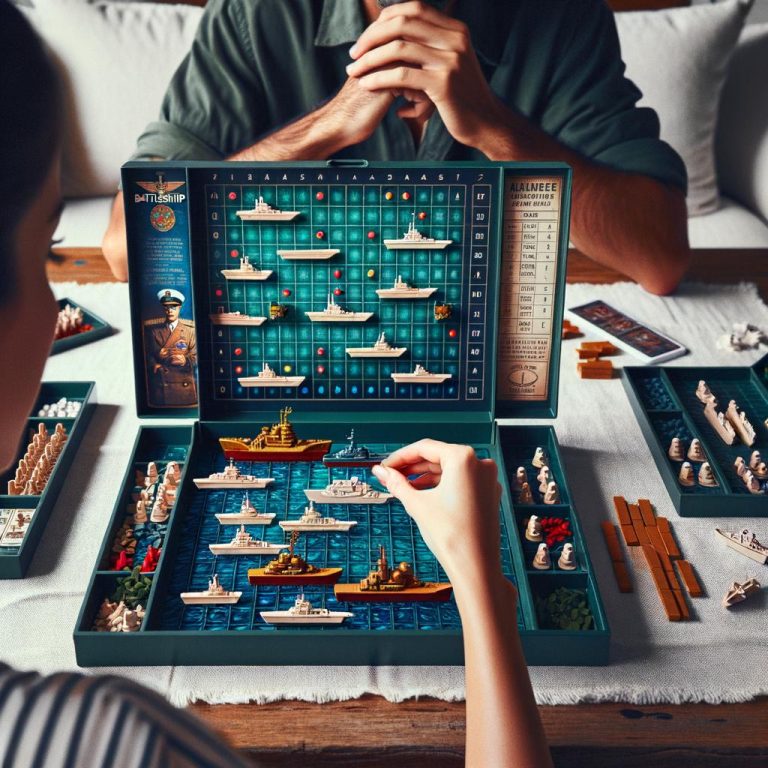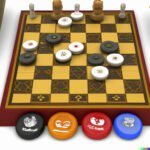Battleship, a classic board game strategy game, has been captivating players of all ages for decades with its blend of luck and skill. This timeless game challenges players to strategically place their fleet of ships on a grid while trying to guess and sink their opponent’s vessels. As one of the most beloved and iconic board games, Battleship continues to be a staple in family game nights and competitive tournaments alike.
The origins of Battleship can be traced back to the early 20th century, evolving from pencil and paper games into the popular tabletop version we know today. With its simple yet engaging gameplay, Battleship has stood the test of time and remains a favorite among casual gamers and enthusiasts. Through various adaptations and updates, the essence of strategic naval warfare in this game has remained constant, captivating generations of players around the world.
Whether you’re a seasoned Battleship player or new to the game, mastering its rules and strategies is key to achieving victory on the high seas. From setting up your fleet to strategically guessing your opponent’s coordinates, Battleship requires keen observation, critical thinking, and a bit of luck.
In this article, we will delve into the history of Battleship, explore its rules and setup, discuss tips for mastering gameplay strategies, and delve into advanced tactics for emerging victorious in this classic board game.
History of Battleship
Battleship, the classic board game that has stood the test of time, has a rich history that dates back to the early 20th century. The game was first known as “Broadsides,” and it was played on paper grids until it evolved into the plastic peg-based version we know today. Initially popularized as a pencil and paper game during World War I, Battleship gained widespread recognition when Milton Bradley released the first mass-produced version in 1967.
The Evolution of Battleship
Over the years, Battleship has undergone several changes and adaptations to cater to different audiences and technological advancements. From its humble beginnings as a pen-and-paper game to the electronic versions available on smartphones and tablets, Battleship has evolved to remain relevant in a digital age while still capturing the essence of its strategic gameplay.
Battleship Goes Global
As Battleship grew in popularity, it spread across borders and became a beloved pastime for players worldwide. Different countries have put their own spin on the game, incorporating unique designs and variations to create culturally diverse experiences. Despite these regional differences, the core mechanics of Battleship remain consistent, emphasizing skillful strategy and tactical thinking in every match.
The enduring appeal of Battleship lies in its simplicity yet challenging gameplay, making it a timeless classic that continues to engage players of all ages. Whether played traditionally on a physical board or digitally through online platforms, Battleship remains a staple in the world of strategy games, showcasing how a simple concept can evolve into an enduring favorite for generations to come.
How to Play Battleship
Battleship, a classic board game of strategy and skill, has been entertaining players for generations. The game is simple yet strategic, requiring players to use deduction and logic to sink their opponent’s fleet of ships. The rules are easy to grasp, making it accessible to players of all ages. In this section, we will delve into the rules and setup of Battleship, guiding both novice and experienced players on how to navigate the seas and emerge victorious.
The objective of Battleship is to sink all of your opponent’s ships before they sink yours. Each player arranges their fleet of ships on a grid without revealing their placement to the other player. The standard fleet consists of five ships: the Carrier (5 spaces), Battleship (4 spaces), Cruiser (3 spaces), Submarine (3 spaces), and Destroyer (2 spaces). Once the fleets are set up, players take turns calling out coordinates to target their opponent’s ships.
Players call out coordinates by selecting a row letter (A-J) and a column number (1-10). For example, if a player calls out “B4,” they are targeting the intersection at row B and column 4 on the grid.
The opponent then responds with either “miss” if there is no ship at that location or “hit” if a ship has been hit. If a player successfully hits all spaces of a ship, they announce “sunk” to indicate that ship has been destroyed.
To win Battleship, you must use strategic thinking to deduce the locations of your opponent’s remaining ships based on previous hits and misses. By analyzing patterns and eliminating possible locations, you can increase your chances of hitting more ships with each turn. Remember to adapt your strategy as the game progresses and be prepared for surprise tactics from your opponent. With practice and perseverance, you can become a master tactician in this beloved classic board game.
| Battleship Classic Board Game Strategy | Rules |
|---|---|
| Emerge victorious by sinking all opponent’s ships | Each player arranges their fleet without revealing placement |
| Target coordinates by calling out row letters and column numbers | Announce “sunk” when all spaces of a ship have been hit |
Mastering Battleship Strategy
Battleship is a classic board game that has been enjoyed by players of all ages for decades. While the game may seem simple at first glance, it actually involves a fair amount of strategy and tactics to outwit your opponent. Mastering Battleship strategy can greatly increase your chances of winning and add depth to the gameplay experience.
One key tip for mastering Battleship strategy is to create patterns in your ship placements that can throw off your opponent. Instead of randomly placing your ships on the board, consider clustering them together or spacing them out in a deliberate manner. This can make it harder for your opponent to guess the locations of your ships and increase the likelihood of hitting their ships first.
Another important tactic in Battleship is to keep track of your opponent’s hits and misses. By paying attention to where they have hit and missed on your board, you can start to narrow down the possible locations of their remaining ships. This information can help you make educated guesses on where to target next, increasing your chances of scoring hits and sinking their fleet.
Overall, mastering Battleship strategy requires a combination of critical thinking, memory skills, and a bit of luck. By following these tips and tactics, you can improve your gameplay and become a formidable opponent in this classic board game.
| Key Strategy | Details |
|---|---|
| Create Patterns | Cluster or space out ship placements strategically. |
| Track Hits/Misses | Keep tabs on opponent’s moves to narrow down ship locations. |
Advanced Strategies for Winning Battleship
In Battleship, mastering the basic strategies is only the beginning. To truly dominate your opponent, you will need to employ advanced tactics that go beyond just guessing coordinates. By incorporating clever mind games, strategic placement of your ships, and analytical thinking, you can increase your chances of sinking all of your opponent’s fleet before they sink yours. In this section, we will delve into some advanced strategies for winning Battleship.
Psychological Warfare: Bluffing and Misdirection
One effective advanced strategy in Battleship is to utilize psychological warfare against your opponent. By strategically bluffing or misdirecting your opponent, you can lead them to waste their shots on decoy areas of the board while keeping your own fleet safe. Feigning distress or false confidence can also throw off your opponent’s game plan and give you the upper hand in the battle.
Pattern Recognition: Analyzing Previous Shots
Another key aspect of advanced Battleship strategy is pattern recognition. By analyzing the locations of previous shots fired by both you and your opponent, you can start to identify patterns and narrow down where their remaining ships might be hiding. Pay close attention to how your opponent responds to hits and misses, as this can provide valuable insights into their ship placements.
Odds Calculation: Maximizing Your Hits
Calculating probabilities and maximizing your hits is essential in winning Battleship. By taking into account the number of remaining ships, possible ship orientations, and uncovered areas of the board, you can strategically position your shots to increase the likelihood of hitting an enemy vessel. This methodical approach requires patience and precision but can greatly improve your overall performance in the game.
Notable Battleship Tournaments and Championships
Battleship has become more than just a classic board game; it has evolved into a highly competitive tournament game with championships held worldwide. Players from different backgrounds and skill levels come together to showcase their strategic prowess and naval combat skills in these esteemed events. Here are some of the most notable Battleship tournaments and championships:
- World Battleship Championship: The World Battleship Championship is the pinnacle of competitive Battleship play, attracting top players from around the globe. Participants battle it out in intense matches, showcasing their ability to sink enemy ships while protecting their own fleet. The championship offers a platform for players to prove themselves as the best in the world.
- National Battleship Tournaments: Countries like the United States, United Kingdom, and Japan host national Battleship tournaments where local talent competes for recognition and prizes. These tournaments often serve as qualifiers for larger international competitions, adding an extra layer of excitement and prestige to the event.
- Online Battleship Leagues: With the rise of digital adaptations of board games, online Battleship leagues have emerged as popular platforms for players to compete against each other virtually. These leagues allow players to sharpen their skills, participate in regular competitions, and even qualify for offline tournaments based on their performance.
Competing in these prestigious events requires not only a deep understanding of the game but also a strategic mindset that can outsmart opponents in battle. From carefully placing your ships on the grid to predicting your opponent’s moves, every decision matters in the world of competitive Battleship.
Whether you’re a seasoned player or new to the game, participating in these tournaments and championships can take your skills to new heights and pave the way for recognition among your peers in the global gaming community.
Joining a Battleship tournament or championship isn’t just about winning; it’s also an opportunity to connect with fellow enthusiasts who share your passion for this classic strategy game. Building friendships, exchanging strategies, and engaging in friendly competition are all part of the experience that makes these events so special.
So if you’re ready to test your mettle against other Battleship aficionados on a grand stage, consider entering one of these prestigious tournaments and championships – because victory awaits those who can outmaneuver their opponents with precision and wit.
The Influence of Battleship on Other Board Games
Battleship, the classic board game strategy game, has had a significant influence on other board games over the years. Its unique combination of deduction, logic, and guessing gameplay has inspired the creation of many other popular titles in the tabletop gaming world. Here are some examples of how Battleship has influenced other board games:
1. Stratego: Just like Battleship, this two-player game involves hidden information and strategic thinking. Players set up their pieces on a grid and attempt to capture their opponent’s flag while protecting their own. The element of bluffing and deducing the location of your opponent’s pieces is reminiscent of the gameplay found in Battleship.
2. Clue (or Cluedo): While not a direct adaptation of Battleship, Clue also involves deducing information through strategic questioning and deductive reasoning. Players move around a mansion trying to solve a murder mystery by eliminating suspects, weapons, and rooms from their list based on clues gathered throughout the game.
3. Code Names: This team-based word association game requires players to give one-word clues to help their teammates identify specific words or pictures on a grid. The need to carefully choose your clues based on limited information mirrors the thoughtful decision-making process seen in Battleship.
Overall, Battleship’s influence can be seen in various board games that emphasize deduction, strategy, and critical thinking skills. Whether it’s uncovering hidden ships or solving a mystery, the legacy of Battleship continues to inspire new generations of gamers to engage in strategic gameplay experiences across different genres and formats.
The Future of Battleship
In recent years, Battleship, the classic board game strategy game, has not only stood the test of time but has also evolved to adapt to modern technology. The future of Battleship now includes digital adaptations and online play, allowing fans of the game to connect and compete in new ways. With the rise of smartphones, tablets, and computers, players can now enjoy the thrill of sinking their opponent’s fleet virtually anytime and anywhere.
The transition to digital platforms has brought a fresh perspective to Battleship gameplay. Online versions of the game often come with interactive features, customizable options, and even virtual reality experiences that enhance the overall gaming experience. Players can now challenge friends or strangers from around the world in real-time battles, adding a new level of excitement and competitiveness to the traditional board game.
As Battleship continues to embrace digital adaptations and online play, it opens up a world of possibilities for both seasoned veterans and newcomers alike. Whether you prefer the nostalgic feel of physical game boards or the convenience of playing on your device, there is no denying that Battleship remains a timeless favorite among strategy game enthusiasts. So gather your fleet, hone your tactics, and get ready to engage in epic naval battles in this exciting new era of Battleship gaming.
Frequently Asked Questions
Is There a Strategic Way to Play Battleship?
There is definitely a strategic way to play Battleship. It involves using logic to eliminate possible locations of your opponent’s ships based on their previous hits and misses. By strategically targeting certain areas, you can increase your chances of hitting their ships.
What Is the Best Guessing Strategy in Battleship?
The best guessing strategy in Battleship is to start by targeting the center of the board, as this gives you the best chance of hitting a ship regardless of its orientation. After a hit, it’s important to probe around that area to determine the direction of the ship and maximize your hits.
What Is the Best Layout for Battleship Game?
The best layout for a Battleship game involves spreading out your ships in different parts of the grid to make it harder for your opponent to guess their locations. Placing them in various orientations and avoiding clustering them together can make it more challenging for your opponent to locate and sink your ships.

I love playing all kinds of games – from classics like Monopoly to modern favourites like Ticket to Ride.
I created this blog as a way to share my love of board games with others, and provide information on the latest releases and news in the industry.





